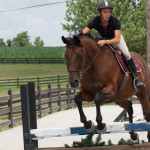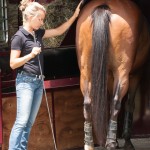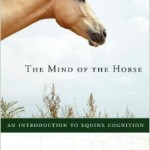My favorite riding book to date is Centered Riding by Sally Swift. I found the examples in this book, while sometimes strange, really helped me visualize and feel how I was balanced and how my horse was moving under me. I believe that this book can be very helpful for both beginning and experienced riders.
Sally Swift was diagnosed with scoliosis at age 8, and because of her condition and the therapies she received, she became very aware of the body, and how it moves and balances. After a brief description of her own equestrian journey, Swift begins with a chapter titled “Pretend You Are a Horse,” which does a great job of explaining why riding centered and riding correctly is so important for the horses comfort and to get the best behavior and movements from your horse.
The book then goes into the basics of finding your center and learning to move with the horse and ride with your seat to achieve balance and harmony with the horse. The many illustrations and pictures help the reader visualize the concepts and positions that Swift describes. Further into the book, Swift describes using centered riding for more advanced movements including collection, extension, lateral work, and jumping.
Every time I open this book I am reminded of another exercise or concept to try on my next ride, but these are the ones that really stood out to me, and if you are one of my students, you will probably recognize these! These first two are for any gait, walk, trot, or canter – as you ride, think of your legs as strings and your feet as lead balls. The weight of your feet lowers your heel, but it is not pushed down and tense. You should have some movement through your lower leg, but the weight of the “lead ball” keeps it quiet. Next, think of your collarbones and shoulders as a yoke, with your upper arms as the ropes holding buckets of water. Similar to the leg example, you should be loose and have some movement through your upper body, but it is kept still by the weight of your arms. Also, you should not tense your arms and shoulders, just let them hang. One more example – my favorite for the posting trot is to imagine a spring stretching from your belt buckle diagonally up to the sky. This pulls your hips more forward, which frees up the horse’s shoulders.
I could go on with more examples, but Sally Swift does a better job of putting them in writing! Click the link below to purchase Centered Riding in Amazon.














2 Responses
I am so enjoying your videos. I used to trail ride a lot, but never with any “formal” training. Now years later, I am riding again and working with a trainer but still struggling with bouncing out of the saddle and finding appropriate use of pressure for balance vs instruction for the horse. Thank you for such clear training videos, both verbally and by example!
Laura Barry
Hi Laura, I have a great video for you on how to stop bouncing in the saddle! Hope it helps 🙂
-Julia Burdy, CRK Training Community Manager